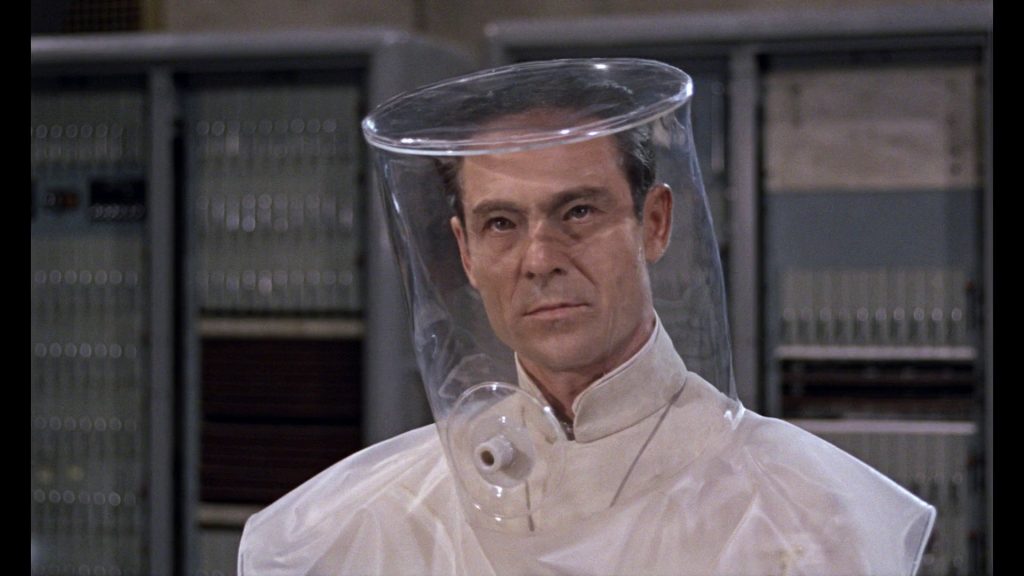Dr. No (1962)
The Cast Sean Connery (James Bond), Ursula Andress (Honey Rider), Jack Lord (Felix Leiter), Zena Marshall (Miss Taro), Joseph Wiseman (Dr.No)
The Supporting Cast Bernard Lee (“M”), Lois Maxwell (Moneypenny), Eunice Gayson (Sylvia Trench)
Credits Produced by Albert R. Broccoli and Harry Saltzman; Directed by Terence Young; Screenplay by Richard Maibaum , Johanna Harwood, and Berkley Mather; Music by Monty Norman; Edited by Peter Hunt
Assignment: Bond is sent to Jamaica to investigate who or what is behind the interference of American space launches from the island of Crab Key.
Locations Covered: MI6 Headquarters (London, England); Jamaica/Crab Key
Villain`s Idiosyncrasy: Steel hands.
Release dates: United Kingdom October 5th, 1962; United States May 8th, 1963
Box Office: 23 million tickets sold = $60 million worldwide ($314 million adjusted for 1999 dollars)
Best lines: Sylvia Trench:”I admire your luck, Mr?”
007: “Bond. James Bond.”
Review by: Cavan Scott
The beautiful woman announces `Banco` and her adversary across the Casino table lights a cigarette as he calmly accepts her challenge. When asked his name, he replies simply `Bond, James Bond`, his cigarette hanging loosely from his lips and the touchpaper for over thirty years of cinematic excitement is lit. Producers, Harry Saltzman and Albert R. Broccoli had long planned a series of films chronicling the adventures of Ian Fleming`s infamous secret agent, but they could never have prophesied the phenomenal success that the franchise would become. Bond had arrived and action heroes were never going to be the same again.
Compared to its 17 sequels, Dr. No is a low key adventure, which rarely rises above the melodrama of it contemporary features. Terence Young`s direction is, at best, average and Monty Norman`s score leads much to be desired, comprising mainly of variations of the lilting `Underneath the Mango Tree` and somewhat annoying repetition of the Bond Theme itself. Two elements save the picture and give it a class which its rivals of the time could only dream of.
The first reason is the film`s loyalty to Fleming`s original novel. This is the nearest that the 007 of the silver screen has ever been to the Bond of the printed page. Although the components of future trademarks are present they are only found in their infancy. Much of the dialogue is adapted directly from the novel, thus holding back the flippancy that would characterize our hero in his later missions. With the absence of Q Branch, Bond must also use his wits rather than a bag of tricks to aid him in his task, as displayed in 007 using such down-to-earth methods such as sticking hair over doors and covering his briefcase locks with talcum power to catch out potential meddlers. We are consequently presented with a grittier image of Bond and his world, which makes him far more human and therefore believable.
In just a few movies this vulnerable Bond who can take a pasting and yet still manage to struggle through despite injuries, would be replaced by a demi-god who never even gets a hair out of place in a moment of danger. No matter how much we would enjoy the future incarnations of Bond, we could never believe that anyone could hurt the agent as much as we saw in Dr No`s assault course, thus reducing the tension. An indestructible hero never has the chance to fail, and a vital dimension of the character is lost.
This is why Dr No can be seen as possibly Sean Connery`s finest performances as James. While he was not Fleming`s own choice for the role – the writer believed that the unknown actor did not possess the social grace to play his hero, favoring David Niven or even the young Roger Moore – Connery oozes confidence in every scene. Here is a man born to play Bond. He is suave and yet stuck in the chauvinistic rut of a past time. In times of crises, he is controlled and cold nevertheless fueled by a supreme of sense of justice and loyalty. The Bond of Dr. No is not a man to be trifled with.
Joining Connery is a fine cast who prove to be more than second fiddles to the star. Bernard Lee is undoubtedly the ideal candidate for M, bringing the right mixture of testiness and strength needed to play the old man, while Lois Maxwell begins her marathon run of deep sigh`s and lingering looks with tongue in cheek canniness. On the side of the devil, Joseph Wiseman`s Dr. No is just a frosty as the novel suggested, with an air of aloof detachment that chills the blood.
Yet no examination of Dr. No is complete without mention of its leading lady. Ask most movie fans what they remember most about the film and it can be guaranteed that their mind will automatically conjure up the image of Ursula Andress rising from the sea. Although she lacks the broken nose of Fleming`s Rider, the Honey of the film perfectly captures the innocence of the author`s creation. Unlike the modern Bond girls who are superficially PC and yet soon revealed to be walking center-folds ready to scream and be captured as the plot requires, Andress is at least given the dignity of playing a naive girl swept into a nightmare and able to show real bravery. She may not please some more radical critics but she is a far more satisfying character than the many token action girls who have succeeded her.
By no means the most thrilling of the Bond movies, yet somehow more adult, Dr. No was the perfect prototype for the world`s most successful film series. Simple but captivating, mundane and yet still extraordinary the cinematic debut of Fleming`s hero grabbed an era`s imagination and wouldn`t loosen its grip until future generations had also become ensnared in his exotic exploits. The adventure was only just beginning.

